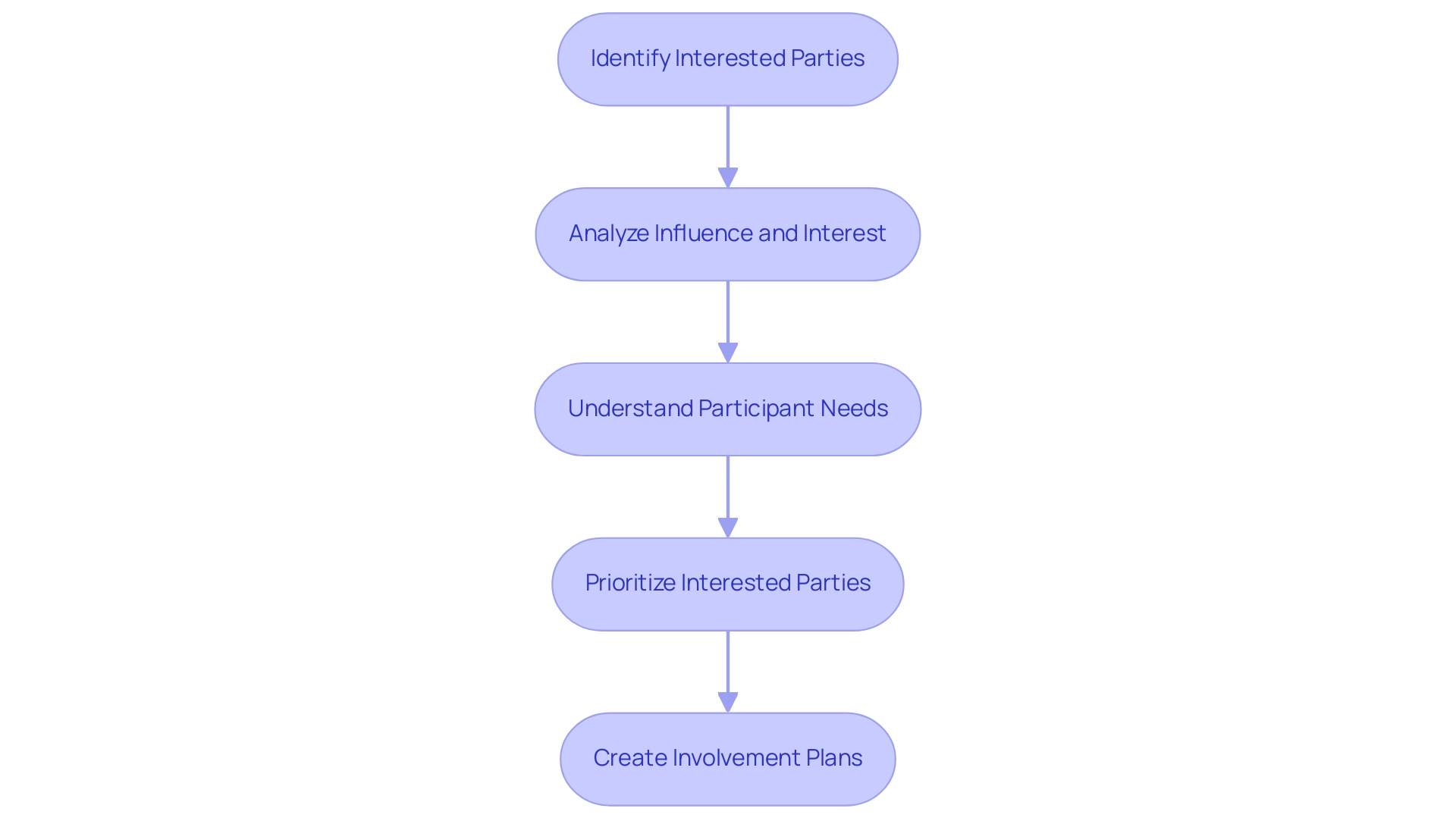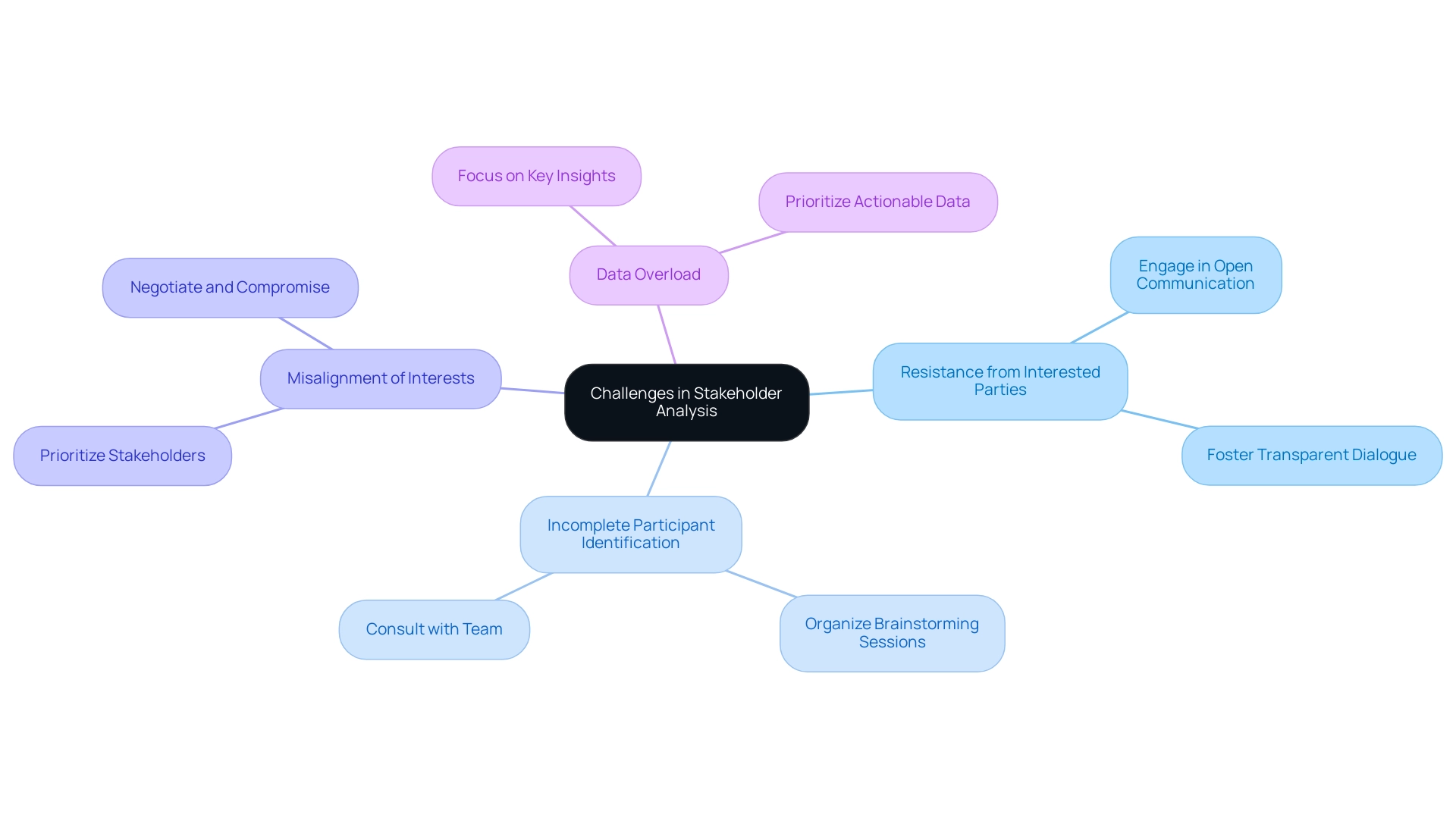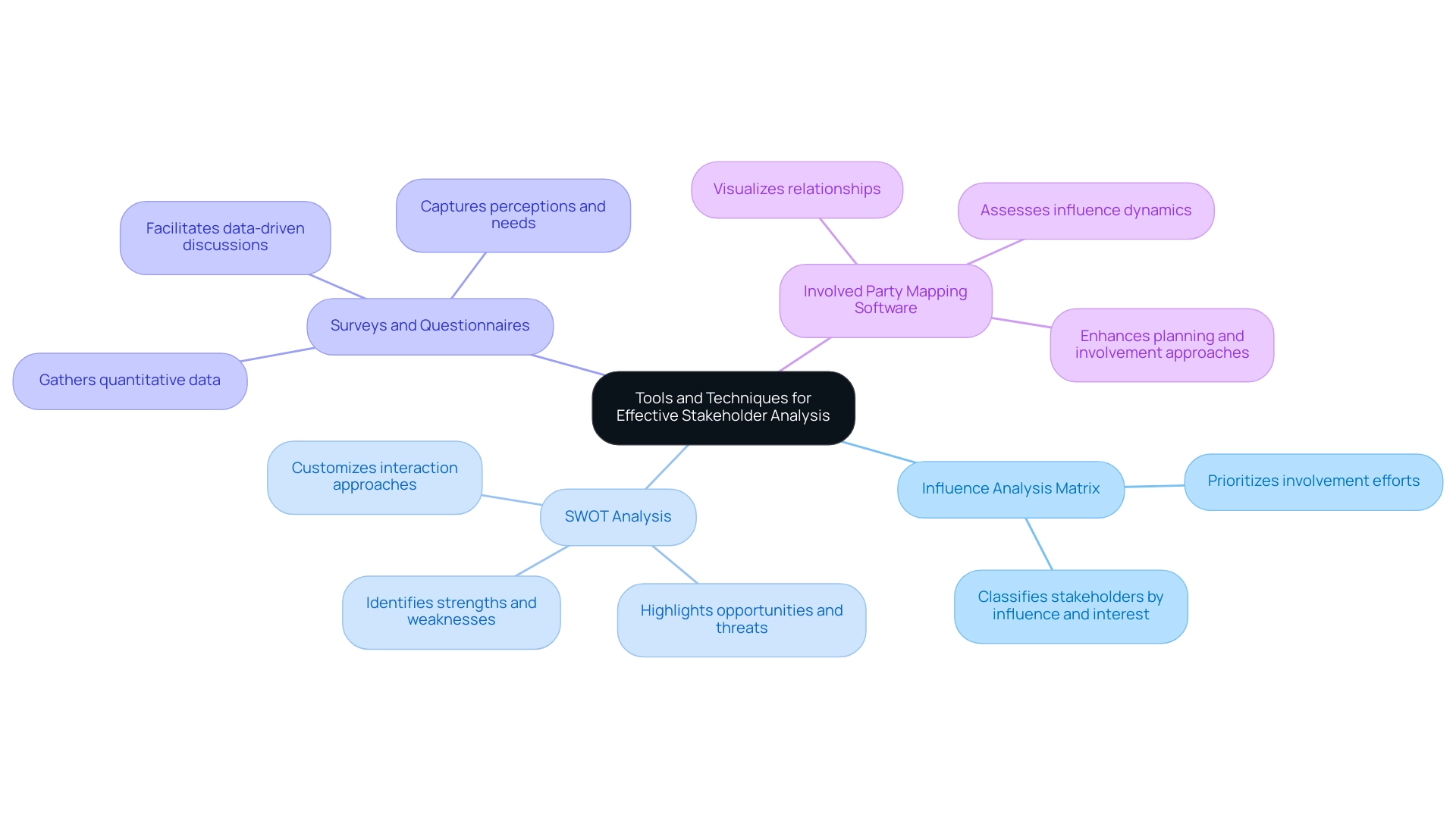Introduction
In the realm of change management, understanding stakeholder dynamics is not just beneficial—it's essential. As organizations navigate the complexities of transformation, CFOs must prioritize stakeholder analysis to identify and engage those who will influence the success of their initiatives. By dissecting the interests, influences, and potential resistances of various stakeholders—from employees to suppliers—leaders can craft targeted strategies that foster commitment and support.
This article delves into the critical steps of stakeholder analysis, practical engagement techniques, and the common challenges that arise, offering CFOs the insights needed to navigate change with confidence and precision. With the right approach, organizations can not only enhance their project outcomes but also cultivate a culture of collaboration and trust that propels them forward.
Understanding Stakeholder Analysis in Change Management
Stakeholder analysis in change management serves as a fundamental approach in recognizing and assessing the impact and requirements of various groups involved in transformation efforts. For CFOs, performing a stakeholder analysis in change management to recognize the various stakeholders—from employees and management to customers and suppliers—is crucial for effective change management. This thorough examination utilizes stakeholder analysis in change management to reveal the interests of involved parties, degrees of possible opposition, and areas of backing, facilitating the creation of focused approaches that directly tackle their issues.
As stated by the Quixy Editorial Team, effective project planning is essential, with 46% of organizations identifying it as a top priority, highlighting the importance of organized interaction approaches. For example, the Supply Chain Director may demonstrate significant influence but low commitment, highlighting the intricacies of participant dynamics and the necessity for customized interaction strategies. By involving interested parties through customized communication, persuasion strategies, and incentives, organizations can enable smoother transitions and greatly enhance the success rates of transformation initiatives.
A systematic approach not only helps in fostering commitment but also enhances overall project performance, as demonstrated by case studies emphasizing the connection between participant involvement and successful project management results, especially noted in the case study titled statistics on Project Management Performance.
Step-by-Step Process for Conducting Stakeholder Analysis
- Identify Interested Parties: Begin by gathering a thorough list of all possible parties who may be impacted by the alteration. This encompasses both internal parties, such as employees and management, and external entities like customers, suppliers, and regulatory bodies.
- Analyze Influence and Interest: Evaluate each participant's level of influence and interest concerning the change initiative. Implementing a structured approach, such as Mendelow’s Matrix, allows you to categorize interested parties effectively into four quadrants: high influence/high interest, high influence/low interest, low influence/high interest, and low influence/low interest. This matrix is crucial for prioritizing involvement strategies and allocating resources effectively. As Yasmin Begum from the Communications Team notes, stakeholder analysis in change management and mapping are crucial steps in the earlier stages of project management to ensure a smooth process and successful outcomes. This stakeholder analysis in change management corresponds with the four key areas of managing interested parties: Identification, Analysis, Mapping, and Prioritization.
- Understand Participant Needs: To tailor your engagement effectively, conduct interviews, surveys, or focus groups aimed at collecting insights into participants’ needs, concerns, and expectations regarding the impending change. This step is vital for aligning your strategy with the viewpoints of interested parties and operationalizing lessons learned to build lasting relationships.
- Prioritize Interested Parties: Utilize the insights obtained from your analysis to prioritize interested parties based on their influence and interest levels. This prioritization will assist you in identifying which parties need urgent attention and proactive involvement, enabling a streamlined decision-making process that maintains business health and allows for quicker responses to emerging issues.
- Create Involvement Plans: Design particular interaction approaches for each group of interested parties, focusing on how to connect with them and include them throughout the transformation process. By integrating real-time business analytics from our client dashboard into your plans, you will enhance their support and mitigate resistance, ensuring a smoother transition and continuous performance monitoring.

Developing Effective Stakeholder Engagement Strategies
To cultivate effective stakeholder engagement strategies during change management, consider implementing the following approaches:
- Tailored Communication: Customize your messaging to resonate with distinct stakeholder groups. Utilize language and channels that align with each group's preferences, recognizing that effective communication is not one-size-fits-all. Recent trends indicate that participants increasingly favor personalized interactions, enhancing their involvement in decision-making processes.
- Regular Updates: Maintaining a routine of updates is crucial. Keeping interested parties informed about the progress of the transformation initiative helps reduce uncertainty and nurtures trust. Consistent communication reassures involved parties about their role in the process and strengthens their commitment. Significantly, the production duration for modifications is consistently 3 minutes, which emphasizes the effectiveness of prompt updates in maintaining participant involvement.
Actively involving key participants in the decision-making process through stakeholder analysis in change management can significantly boost their sense of ownership and dedication to transformation. By soliciting their input, you not only empower them but also leverage their insights to refine strategies. This collaborative approach, which includes stakeholder analysis in change management, leads to more robust decision outcomes.
- Feedback Mechanisms: Conducting a stakeholder analysis in change management by establishing channels for participants to provide ongoing feedback throughout the change initiative is vital. Actively listening to their concerns not only uncovers valuable insights but also allows for necessary adjustments in your approach. Regular assessment of communication practices, along with input from involved parties, can significantly enhance engagement effectiveness.
In a notable case study titled Crossing Cultural and Linguistic Barriers, it was demonstrated that participants from diverse cultural backgrounds benefit from tailored communication strategies. By understanding cultural nuances, providing targeted training, and employing visual aids, organizations successfully enhanced communication and fostered healthy relationships with involved parties. This demonstrates that effective engagement necessitates a keen awareness of diverse participants.
As Francis Dupont, an Account Director, suggests, "Outside of work, I love being on the lake to catch big bass, cooking on the BBQ, and growing beautiful flowers!" This viewpoint underscores the significance of involving relevant parties in a way that connects with their individual interests, further stressing the necessity for customized communication strategies.
Navigating Challenges in Stakeholder Analysis
Stakeholder analysis in change management presents several common challenges that can significantly impact the effectiveness of your initiatives. Identifying and tackling these challenges is vital for achieving successful results:
- Resistance from Interested Parties: It's not unusual for interested parties to show resistance due to a fear of change. To mitigate this, it’s essential to engage in open communication about the analysis's purpose and the benefits it holds for them. By fostering a transparent dialogue, you can alleviate concerns and encourage buy-in.
- Incomplete Participant Identification: One of the most critical pitfalls is failing to identify all relevant participants. This oversight can create gaps that undermine the analysis. To combat this, organize brainstorming sessions and consult with your team to compile a thorough list of interested parties. This collaborative method ensures that no key participants are overlooked.
- Misalignment of Interests: The diverse interests of involved parties can complicate the analysis process. It is essential to prioritize stakeholders based on their influence and significance to the initiative. Addressing conflicting interests through negotiation and compromise will facilitate smoother collaboration and enhance engagement.
- Data Overload: In the quest for comprehensive information, teams often fall into the trap of data overload, leading to analysis paralysis. To prevent this, concentrate on extracting key insights that directly influence the initiative. Prioritize actionable data that can drive decision-making and implementation, streamlining the process and enhancing efficiency.
Research shows that only around 20% of organizations systematically measure the outcomes of their transformation efforts, underscoring the need for robust evaluation processes. This statistic highlights the importance of a structured approach to stakeholder analysis in change management. Moreover, management of transitions is an ongoing journey of adaptation and evolution, requiring commitment and a willingness to learn from each initiative.
By proactively addressing these challenges, as illustrated in the case study on Measurement and Evaluation, where organizations struggled with effective assessment, you position your organization for greater success in managing transitions.

Tools and Techniques for Effective Stakeholder Analysis
To successfully involve interested parties during management initiatives, consider utilizing the following advanced tools and techniques:
- Influence Analysis Matrix: This visual tool classifies interested parties based on their level of influence and interest, allowing you to prioritize involvement efforts successfully. By concentrating on high-influence parties, your stakeholder analysis in change management can guarantee that your transformation initiatives obtain the essential support and resources.
- SWOT Analysis: Performing a SWOT analysis for key players offers valuable insights into their strengths, weaknesses, opportunities, and threats related to the transformation initiative. This assessment enables you to customize your interaction approaches to address the concerns of interested parties while leveraging their strengths through stakeholder analysis in change management.
- Surveys and Questionnaires: Utilize online survey tools to gather quantitative data from a broader audience. This method not only captures perceptions and needs of involved parties but also aids in quantifying the effect of proposed modifications, facilitating data-driven discussions.
- Involved Party Mapping Software: Advanced mapping software assists in visualizing relationships and assessing influence dynamics among involved parties. By utilizing these tools, you can create more efficient planning and involvement approaches that include stakeholder analysis in change management, ensuring that concerns of interested parties are addressed proactively.
Mia Kastanakis, a Change Management Analyst, emphasized the significance of collaboration in this process, stating,
Collaborated with HR to develop a change champion network of 50 employees across all levels, accelerating communication effectiveness by 60% and reducing change implementation time by 25%
Furthermore, the case study on participant analysis for ERP implementation demonstrates the effectiveness of these tools in a real-world scenario, achieving a remarkable 95% user satisfaction rate post-implementation. Furthermore, Lila Kostovski's achievement in establishing a data-driven decision-making culture, leading to a 35% rise in project ROI and a 20% decrease in change-related risks, highlights the significance of efficient involvement approaches.
Covington's Master of Science in Change Management from Georgetown University further enhances the authority of these recommendations. By adopting these tools and strategies, CFOs can enhance stakeholder engagement by implementing stakeholder analysis in change management to drive successful change initiatives.

Conclusion
Understanding stakeholder dynamics is pivotal for CFOs aiming to steer successful change management initiatives. The process starts with a thorough stakeholder analysis, which not only identifies key players but also evaluates their influence, interests, and potential resistance. By employing structured methodologies such as Mendelow’s Matrix, CFOs can prioritize their engagement strategies, ensuring that resources are allocated effectively to those who matter most.
Effective engagement strategies are multifaceted, emphasizing tailored communication, regular updates, and collaboration in decision-making. Such approaches foster trust and commitment, ultimately enhancing stakeholder buy-in. Furthermore, establishing feedback mechanisms ensures that stakeholder voices are heard, allowing for necessary adjustments throughout the change process.
However, challenges such as stakeholder resistance, incomplete identification, and data overload can hinder progress. Addressing these issues proactively through open communication and focused analysis is essential for maintaining momentum. Utilizing advanced tools like stakeholder analysis matrices and SWOT analyses can streamline efforts and improve engagement outcomes.
In summary, prioritizing stakeholder analysis and engagement is not merely beneficial; it is essential for the success of change initiatives. By recognizing the importance of stakeholder dynamics and implementing targeted strategies, CFOs can navigate the complexities of change with confidence, ultimately driving their organizations toward successful transformations. Embracing these practices will cultivate a culture of collaboration and trust, positioning organizations to thrive in an ever-evolving landscape.
Frequently Asked Questions
What is stakeholder analysis in change management?
Stakeholder analysis in change management is a fundamental approach used to recognize and assess the impact and requirements of various groups involved in transformation efforts. It helps identify stakeholders such as employees, management, customers, and suppliers, revealing their interests, potential opposition, and areas of support.
Why is stakeholder analysis important for CFOs?
For CFOs, performing stakeholder analysis is crucial for effective change management as it allows them to understand the dynamics of different stakeholders, tailor communication strategies, and create focused approaches that address the specific issues of involved parties.
What are the steps involved in conducting stakeholder analysis?
The steps include: 1. Identify Interested Parties: Gather a comprehensive list of all internal and external parties affected by the change. 2. Analyze Influence and Interest: Evaluate each party's level of influence and interest using tools like Mendelow’s Matrix. 3. Understand Participant Needs: Conduct interviews or surveys to gather insights on stakeholders' needs and concerns. 4. Prioritize Interested Parties: Use the insights to prioritize stakeholders based on their influence and interest levels. 5. Create Involvement Plans: Design tailored interaction strategies for each group to ensure their engagement throughout the transformation process.
What challenges can arise during stakeholder analysis?
Common challenges include: - Resistance from interested parties due to fear of change. - Incomplete identification of participants, leading to gaps in analysis. - Misalignment of diverse interests among stakeholders. - Data overload, which can hinder effective decision-making.
How can organizations enhance stakeholder engagement during change management?
Organizations can enhance engagement by: - Implementing tailored communication strategies that resonate with different stakeholder groups. - Providing regular updates to keep stakeholders informed and reduce uncertainty. - Establishing feedback mechanisms to listen to participants' concerns and make necessary adjustments.
What tools can be utilized for effective stakeholder analysis?
Useful tools include: - Influence Analysis Matrix: Classifies stakeholders based on their influence and interest. - SWOT Analysis: Assesses strengths, weaknesses, opportunities, and threats of key stakeholders. - Surveys and Questionnaires: Gathers quantitative data on stakeholders' perceptions and needs. - Involved Party Mapping Software: Visualizes relationships and influence dynamics among stakeholders.
How does stakeholder analysis impact project performance?
A systematic approach to stakeholder analysis fosters commitment and enhances overall project performance, as evidenced by case studies linking participant involvement with successful project management outcomes.




